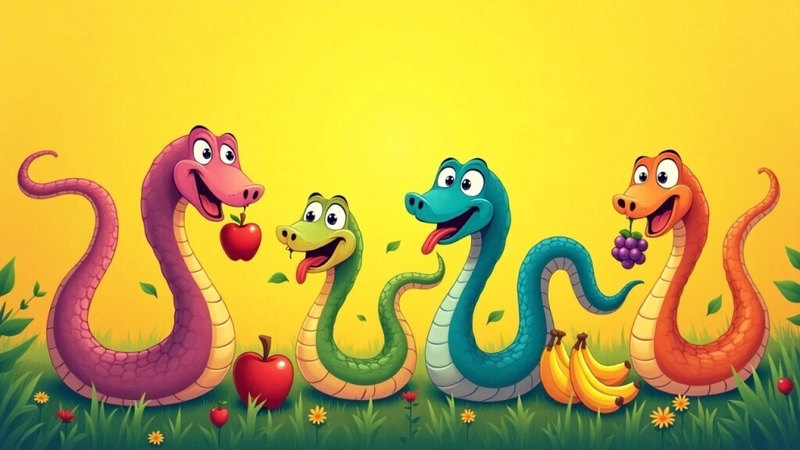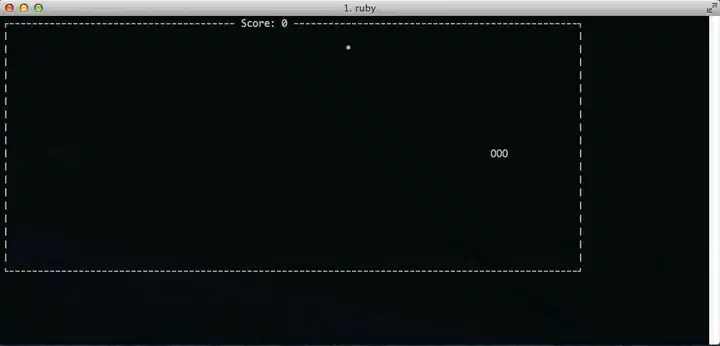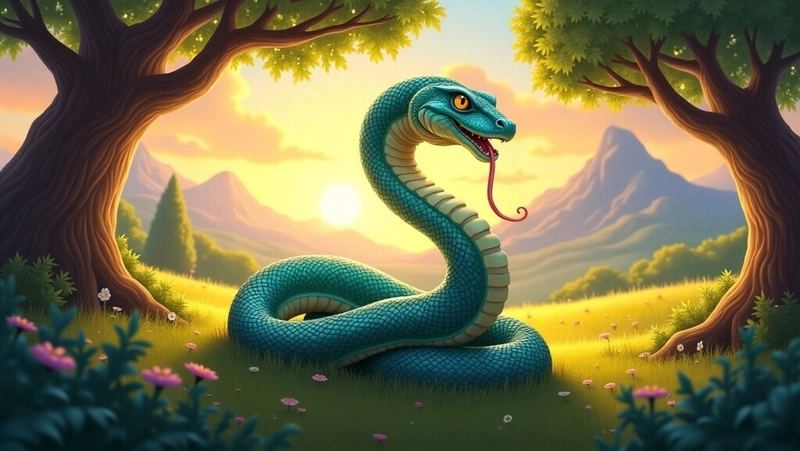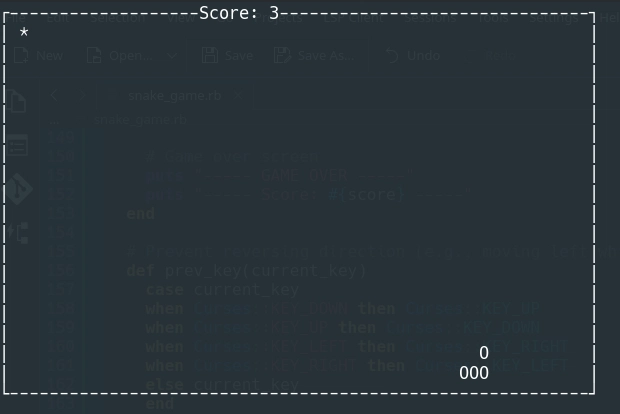February 27, 2025
There’s something timeless about the Snake game—a simple yet addictive concept that has captivated players for decades. From old-school Nokia phones to modern programming projects, this classic game continues to inspire developers to flex their coding muscles. Recently, I decided to take a trip down memory lane and recreate the Snake game using Ruby and the curses library. Along the way, I learned some valuable lessons about modular design, debugging, and how not to let your code “snake” its way into chaos!
Need Expert Ruby on Rails Developers to Elevate Your Project?

Need Expert Ruby on Rails Developers to Elevate Your Project?
Why Build a Snake Game?
Before we dive into the code, let’s address the elephant (or should I say snake?) in the room: Why build a Snake game in 2025?
- Nostalgia Meets Learning : The Snake game is a perfect sandbox for practicing fundamental programming concepts like object-oriented design, user input handling, and collision detection.
- A Fun Challenge : It’s a great way to test your problem-solving skills while having fun. After all, who doesn’t love watching a digital snake grow longer with every bite of food?
- Terminal-Based Graphics : Using Ruby’s curses library, you can create interactive terminal applications—a skill that’s both practical and impressive
And let’s be honest, it’s always satisfying to see your code come to life as a playable game.
How Does the Code Work?
The implementation is divided into four main components:
1. The Food Class
The Food class represents the food that the snake eats. It randomly generates positions within the game window and ensures the food doesn’t spawn on the snake itself.
class Food
DEFAULT_SYMBOL = "*"
def initialize(window, x = nil, y = nil)
@window = window
@x = x || generate_random_x
@y = y || generate_random_y
@symbol = DEFAULT_SYMBOL
@points = 1
end
def relocate_without_conflict!(snake)
loop do
@x = generate_random_x
@y = generate_random_y
break unless snake.include?([@x, @y])
end
end
end
2. The Snake Class
The Snake class inherits from Ruby’s Array to represent the snake’s body as a list of coordinates. It includes a crashed? method that uses a Set to detect collisions efficiently.
class Snake < Array
SYMBOL = 'O'
def crashed?
visited = Set.new
each do |position|
return true if visited.include?(position)
visited << position
end
false
end
end
3. The TermWindow Class
The TermWindow class manages the game display using the curses library. It draws the snake, food, and game boundaries, providing a clean and interactive interface.
class TermWindow < Curses::Window
DEFAULT_WIDTH = 60
DEFAULT_HEIGHT = 20
def initialize(height = DEFAULT_HEIGHT, width = DEFAULT_WIDTH)
super(height, width, 0, 0)
self.box('|', '-')
self.keypad = true
end
def paint_food(food)
setpos(food.y, food.x)
addstr(food.symbol)
refresh
end
end
4. The Game Class
The Game class ties everything together, handling user input, snake movement, collision detection, and scoring. It also allows the snake to wrap around the screen edges, giving it an endless playground to explore—or crash in.
class Game
def run
key = Curses::KEY_RIGHT
score = 0
loop do
# Handle user input, move the snake, check for collisions, etc.
end
end
end
How to Run the Game
Running the game is straightforward:
- Install the curses Gem :
- Save the Code : Copy the complete code into a file, e.g., snake_game.rb.
- Run the Game :
Controls are simple: Use the arrow keys (UP, DOWN, LEFT, RIGHT) to control the snake, and press ESC to exit.
Key Features
- Dynamic Food Placement : Food relocates to a new position after being eaten.
- Collision Detection : The game ends if the snake collides with itself.
- Wall Wrapping : The snake can cross screen edges and reappear on the opposite side
A Joke to Keep Things Light
Why did the snake refuse to play hide-and-seek? Because it always ended up hissing under pressure!
But seriously, building this game was a fantastic learning experience. It reinforced my understanding of object-oriented programming, modular design, and the importance of debugging (because trust me, there were plenty of bugs along the way).
Final Thoughts
Recreating the Snake game in Ruby was a delightful blend of nostalgia and technical challenge. Whether you’re a seasoned developer or just starting out, I encourage you to try building your own version of this classic game. Who knows? You might discover new ways to improve it—like adding obstacles, levels, or even multiplayer mode!
Feel free to share your thoughts or ask questions in the comments. Happy coding, and remember: don’t let your projects get tangled up like a snake in a knot! 

Complete source code:
require 'curses'
require 'set'
# Food class representing the food in the game
class Food
attr_accessor :window, :points, :symbol, :x, :y
DEFAULT_SYMBOL = "*"
def initialize(window, x = nil, y = nil)
@window = window
@x = x || generate_random_x
@y = y || generate_random_y
@symbol = DEFAULT_SYMBOL
@points = 1
end
# Check if the snake has eaten the food
def has_been_eaten_by?(snake)
snake[0][0] == @x && snake[0][1] == @y
end
# Relocate the food to a new position without conflict
def relocate_without_conflict!(snake)
loop do
@x = generate_random_x
@y = generate_random_y
break unless snake.include?([@x, @y])
end
end
private
def generate_random_x
rand(1..@window.width - 2)
end
def generate_random_y
rand(1..@window.height - 2)
end
end
# Snake class representing the snake in the game
class Snake < Array
SYMBOL = 'O'
# Check if the snake has crashed into itself
def crashed?
visited = Set.new
each do |position|
return true if visited.include?(position)
visited << position
end
false
end
end
# TermWindow class managing the game display
class TermWindow < Curses::Window
DEFAULT_WIDTH = 60
DEFAULT_HEIGHT = 20
attr_accessor :width, :height
def initialize(height = DEFAULT_HEIGHT, width = DEFAULT_WIDTH)
super(height, width, 0, 0)
@width, @height = width, height
self.box('|', '-')
self.keypad = true
end
# Paint the food on the screen
def paint_food(food)
setpos(food.y, food.x)
addstr(food.symbol)
refresh
end
# Paint the snake on the screen
def paint_snake(snake)
setpos(snake[0][1], snake[0][0])
addstr(Snake::SYMBOL)
refresh
end
end
# Game class managing the main game logic
class Game
INVISIBLE_CURSOR = 0
attr_reader :window, :snake
def initialize
@window = TermWindow.new
@snake = Snake.new([[4, 10], [4, 9], [4, 8]])
end
def create
Curses.init_screen
Curses.cbreak
Curses.noecho
Curses.curs_set(INVISIBLE_CURSOR)
run
ensure
Curses.close_screen
end
private
def run
key = Curses::KEY_RIGHT
score = 0
food = Food.new(@window)
food.relocate_without_conflict!(@snake)
@window.paint_food(food)
loop do
# Display score
@window.setpos(0, (@window.width / 2) - 10)
@window.addstr("Score: #{score}")
# Handle user input
event = @window.getch
key = event == -1 ? key : event
key = prev_key(key) unless valid_key?(key)
# Move the snake
move_snake(key)
# Check for crashes
break if @snake.crashed?
# Check if food is eaten
if food.has_been_eaten_by?(@snake)
score += food.points
food = Food.new(@window)
food.relocate_without_conflict!(@snake)
@window.paint_food(food)
else
last_part = @snake.pop
@window.setpos(last_part[1], last_part[0])
@window.addstr(' ')
end
@window.paint_snake(@snake)
end
# Game over screen
puts "----- GAME OVER -----"
puts "----- Score: #{score} -----"
end
# Prevent reversing direction (e.g., moving left while heading right)
def prev_key(current_key)
case current_key
when Curses::KEY_DOWN then Curses::KEY_UP
when Curses::KEY_UP then Curses::KEY_DOWN
when Curses::KEY_LEFT then Curses::KEY_RIGHT
when Curses::KEY_RIGHT then Curses::KEY_LEFT
else current_key
end
end
# Validate user input
def valid_key?(key)
[Curses::KEY_DOWN, Curses::KEY_UP, Curses::KEY_LEFT, Curses::KEY_RIGHT, 27].include?(key)
end
# Move the snake based on the current key
def move_snake(key)
case key
when Curses::KEY_DOWN
@snake.unshift([@snake[0][0], @snake[0][1] + 1])
when Curses::KEY_UP
@snake.unshift([@snake[0][0], @snake[0][1] - 1])
when Curses::KEY_LEFT
@snake.unshift([@snake[0][0] - 1, @snake[0][1]])
when Curses::KEY_RIGHT
@snake.unshift([@snake[0][0] + 1, @snake[0][1]])
end
# Wrap around walls
@snake[0][0] = 1 if @snake[0][0] == 0
@snake[0][1] = 1 if @snake[0][1] == 0
@snake[0][0] = @window.width - 2 if @snake[0][0] == @window.width - 1
@snake[0][1] = @window.height - 2 if @snake[0][1] == @window.height - 1
end
end
# Run the game
Game.new.create








Top comments (0)